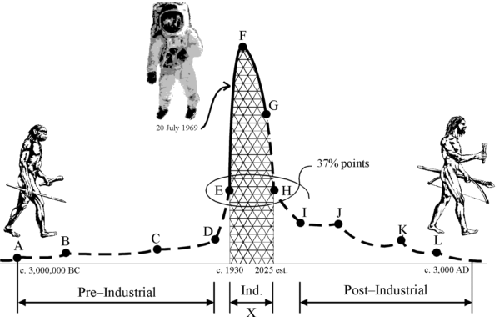Open Thread - 02-16-24 - Get Back
Submitted by JtC on Fri, 02/16/2024 - 7:21am
The Olduvai Theory was proposed originally in 1989 by Richard C. Duncan and was originally called The pulse-transient theory of industrial civilization. In 1996 Duncan published a paper The Olduvai theory: falling towards a post-industrial stone-age era and the theory was subsequently renamed The Olduvai Theory. Olduvai Gorge is considered the cradle of mankind because of the oldest human skeletal remains being discovered there, although that is controversial.
The Olduvai Theory is based primarily on peak oil theory and postulates that mankind progressed outward and upwards from its birthplace in the Olduvai Gorge and reached the apex of civilization brought on by cheap energy, and with the advent of collapse brought on by peak oil, will be on the march back to the metaphorical Gorge and the hunter-gatherer way of life.
The Olduvai Theory of Industrial Civilization1. Pre-Industrial Phase [c. 3,000,000 BC to 1765]
- A = Tool making begins (c. 3,000,000 BC)
- B = Fire use begins (c. 1,000,000 BC)
- C = Neolithic Agricultural Revolution (c. 8,000 BC)
- D = Watt's steam engine, 1765
Interval D-E is a transition period.
2. Industrial Phase [1930 to 2025, estimated]
- E = Industrial Civilization is defined to begin in 1930 when the leading-edge value of energy-use per person reached 37% of its peak value.
- F = Peak of Industrial Civilization, c. 1978: confirmed by historic data published by BP, IEA, USCB, UN, etc.
- G = World average energy-use per person continues to fall, 1996
- H = Industrial Civilization is defined to end when energy-use per person shrinks to 37% of its peak value, forecast to occur by 2025. Life-expectancy (X) is estimated to be less than 100 years.
Interval H-I is a transition period.
3. Post-Industrial Phase [c. 2100 and beyond]
- J, K, and L = Recurring future attempts at industrialization fail.


